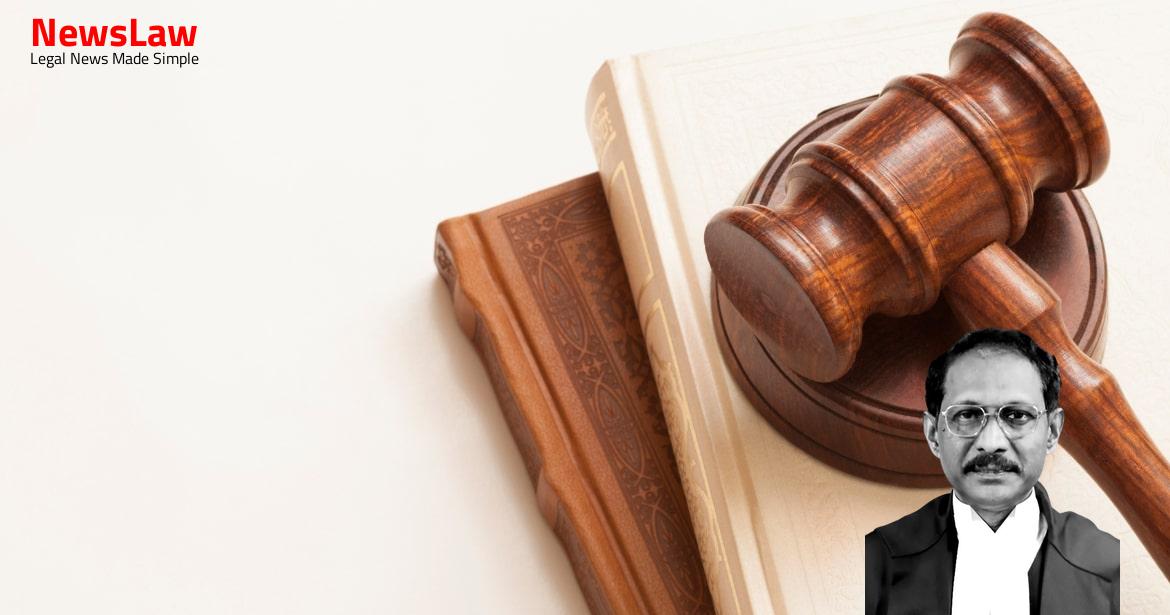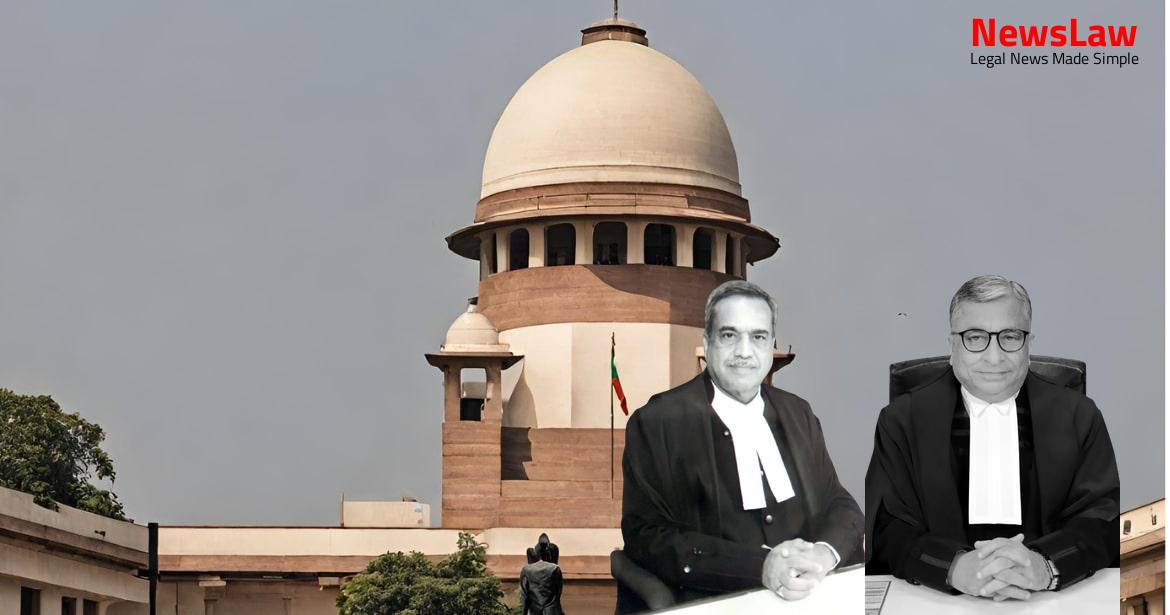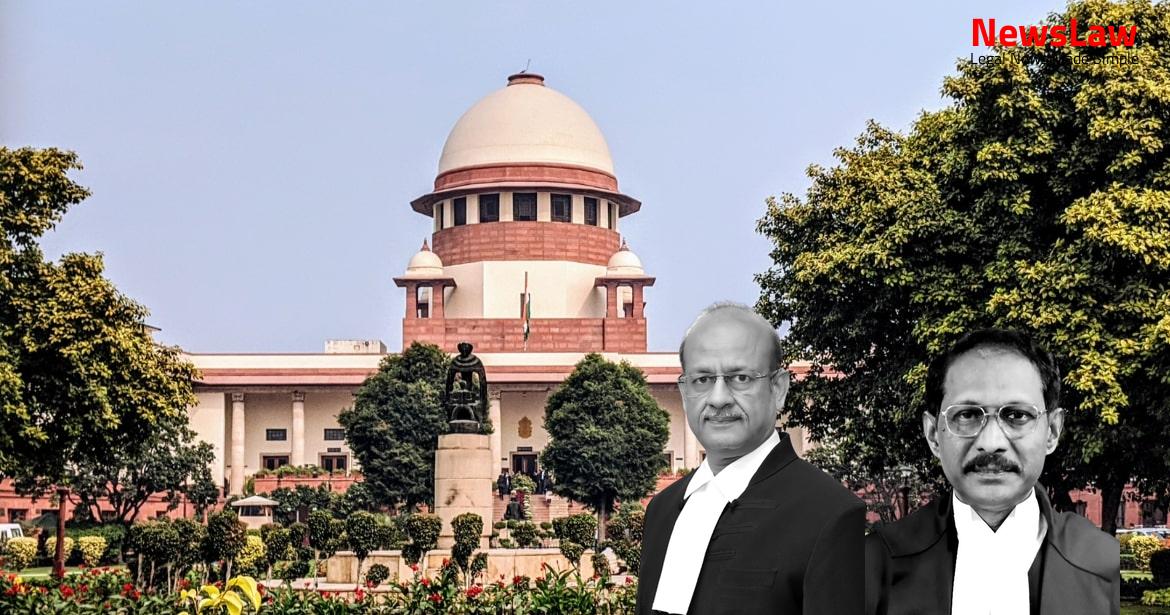Explore the intricate legal analysis by the court regarding property release in a debt recovery dispute. The case delves into the complex dynamics of securing outstanding dues from borrowers and the interpretation of SARFAESI Act provisions. This summary focuses on the court’s meticulous examination of the borrower’s liability and the bank’s rights in the auction process. Stay tuned for a deeper dive into the legal intricacies of debt recovery cases.
Facts
- Appellant bank challenged interim order passed by DRT before DRAT
- Appellant bank argued bids at public auction were higher than amount deposited by borrower
- Bank claimed borrower should pay entire outstanding amount, not just the deposited sum
- DRAT upheld DRT’s order as borrower was willing to pay the highest bid of Rs.71 lakhs
- Single Judge set aside both DRT and DRAT orders for contravening SARFAESI Act
- Division Bench allowed borrower’s appeal, directed bank to release property on further payment of Rs.17 lakhs
- Bank appealed against Division Bench’s judgement
- The appellant bank granted a term loan and cash credit limit to the borrower against the security of two mortgaged properties.
- The borrower failed to repay the term loan leading to the account becoming NPA.
- Notice under Section 13(2) of the SARFAESI Act, 2002 was served demanding a sum of Rs.1,85,37,218.80/-.
- Bank took possession of the residential house after the borrower’s default.
- Sale notice by public auction of the residential property was issued with a reserve price of Rs.48.65 lakhs.
- Borrower challenged the auction by filing a Securitisation Application before the DRT, Jaipur.
- Interim order by DRT required the borrower to deposit Rs.20 lakhs to proceed with the auction.
Also Read: Ruling on Circumstantial Evidence in Murder Case
Arguments
- The appellant – bank argued that the borrower should not be discharged from the entire liability outstanding against him upon payment of Rs.71 lakhs as the total due was Rs. 1,85,37,218.80/- as on 07.01.2013.
- The Division Bench of the High Court erred in directing the release of the secured property for a total sum of Rs.65.65 lakhs, which is contrary to Sub-section (8) of Section 13 of the SARFAESI Act, 2002.
- The appellant – bank contended that the reserve price of Rs.48.65 lakhs was an interim order from the DRT, and the actual market price from the auction could have been higher than Rs.71 lakhs.
- The Division Bench failed to consider that the release of the property upon payment of Rs.71 lakhs did not discharge the entire liability, and the borrower should have paid the full outstanding dues along with all costs and expenses incurred by the secured creditor.
- The Division Bench misunderstood the understanding between the bank and the borrower regarding the payment of Rs.71 lakhs and discharge of the liability.
- Mrs. Christi Jain vehemently opposes the present appeal on behalf of the respondents, the borrowers.
- The highest bid received by the bank in the public auction was Rs.71 lakhs, which the borrower agreed to pay.
- The borrower had already deposited Rs.48.65 lakhs as per the DRT order.
- The Division Bench of the High Court directed the bank to release the property upon a further payment of Rs.17 lakhs, totaling Rs.65.65 lakhs.
- The High Court’s order is deemed equitable and does not require intervention by the Supreme Court under Article 136 of the Constitution of India.
- The appellant’s counsel also agreed that the property could be released upon payment of Rs.65.65 lakhs.
Also Read: Challenging Legal Presumptions in Negotiable Instrument Cases
Analysis
- The Division Bench of the High Court erred in directing the release of the mortgaged property to the borrower on payment of Rs.65.65 lakhs.
- The DRT’s interim relief order directing the release of the property to the borrower was not justified.
- The borrower must deposit the entire outstanding amount before being discharged from liability.
- The bank cannot be restrained from selling the property unless the full dues are paid by the borrower.
- The DRT’s order and subsequent actions of the High Court were in violation of SARFAESI Act provisions.
- The total outstanding dues were Rs.1,85,37,218.80 as of 07.01.2013.
- The borrower’s offer of Rs.71 lakhs was not for redeeming the property but as a potential purchaser.
- Paying Rs.65.65 lakhs does not discharge the borrower’s full liability.
- Even if the property was sold for Rs.71 lakhs, the borrower would still be liable for the balance amount.
- The High Court’s order is contrary to Section 13(8) of the SARFAESI Act.
- The entire liability of the borrower cannot be considered discharged by any payment less than the total outstanding dues.
Also Read: Legal Analysis Critique in High Court’s Quashing Order
Decision
- The present appeal succeeded in recovering outstanding dues from the borrower.
- DRT will decide and dispose of SA No. 09/2014 filed by the borrower under Section 17 of the SARFAESI Act.
- Borrower’s possession of the residential property should not be disturbed until the auction is finalized and the property is sold.
- The impugned judgment and order of the Division Bench of the High Court were quashed and set aside.
- The peaceful and vacant possession of the property is to be handed over to the bank or the auction purchaser.
- The bank can proceed with auction proceedings by inviting fresh bids for the residential house.
- Original title deeds of the mortgaged property are to be retained by the bank.
- The borrower shall not transfer or alienate the mortgaged property until sold in public auction.
- No costs ordered in the present circumstances.
Case Title: BANK OF BARODA Vs. M/S KARWA TRADING COMPANY (2022 INSC 169)
Case Number: C.A. No.-000363-000363 / 2022



